I. What are the Various Components of the Skeletal System?
206 — it’s not just the area code for the Seattle metropolitan area, but also is a number referring to the number of bones within the human body! I guess in a way it’s a little fitting that we’re talking about Seattle as it’s the setting for Grey’s Anatomy while we’re also getting a little introduction to skeletal anatomy!
Lucky for us, the MCAT doesn’t put too much of an emphasis in regards to having a deep understanding of the skeletal structures; however, we’ll at least provide you with all the basics so that you’ll be equipped with a brief overview of the topic before test day. Let’s get started!
II. Macro to Micro Covering of the Skeletal System
Because the skeletal system is so vast and extensive, it’s best to again break down the covering of the system into a macro and microscale.
The macroscale deals with a bigger, overall picture of the skeletal system while the microscale (which is usually of more emphasis on the MCAT) goes more in depth on the structures of individual bones and their microscopic histology!
A. Macroscale Covering
As mentioned above, the macroscale viewpoint of the skeletal system primarily deals with understanding the main breakdown of the skeletal system on a grander scale!
I. Broad Categorization of the Skeletal System
We can divide the skeleton into 2 main divisions: the axial and appendicular skeleton. The axial skeleton gets its name from the bones which comprise the central axis of the body and includes bones like your skull, vertebrae, thoracic cage, etc.
Conversery, the appendicular skeleton consists of all the bones outside of the axial skeleton. The appendicular skeleton gets its name from how the bones attach (or append) to the axial skeleton — it’s the same idea for where we get the term “appendages” from!
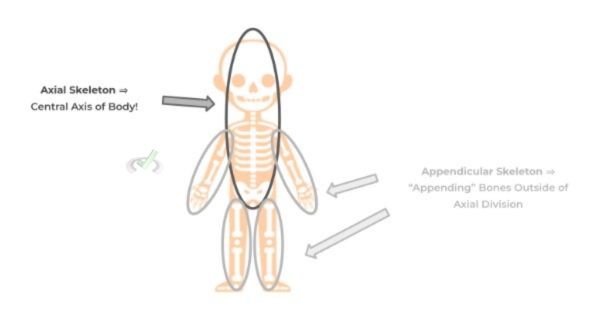
In a way, it somewhat resembles the categorization of the nervous system: the CNS primarily comprises the brain and spinal cord while the PNS encompasses all the nerves outside the CNS.
II. Points of Attachment and Movement
Another important concept to touch upon is understanding how bones attach to one another as well as how muscles attach to bones in order to allow for movement — the 2 connective tissues important for bone attachment are ligaments and tendons.
A ligament is a type of connective tissue which attaches one bone to another bone. Conversely, a tendon is the connective tissue which attaches a bone to a muscle. Shown below is a diagram of these 2 tissues using the humerus and radial bone as an example.
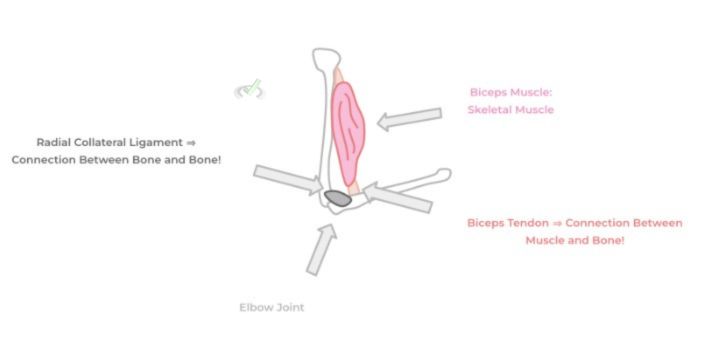
In addition, you saw the joint labeled in the diagram — a joint is an interaction point between 2 bones where movement can occur about an axis! Take a look below at a diagram of a joint using the
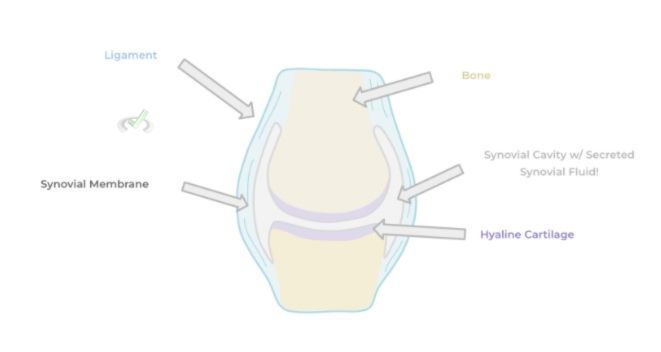
As shown above, joints are often accompanied by the respective tendons and ligaments associated with those bones and muscles. Joints also consist of hyaline cartilage, another type of connective tissue which lines the surface of the bones where they interact with one another.
Finally, another type of connective tissue associated with joints are synovial membranes which line joints in order to secrete synovial fluid. The main role of the synovial fluid and hyaline cartilage is to reduce the friction stress between the bones during movement!
B. Microscale Covering
In this section, we’ll primarily cover some of the main common structures shared between bones as well as some basic microscopic histology related to bone tissue — in fact, bone is actually considered a connective tissue as it fulfills the requirement for the definition as we’ll touch on later!
I. Basic Structure of Long Bone
We’ll primarily cover the structure of the long bone as it’s one of the types of bones that has a more complex structure and is the one often most tested! Superficially, the long bone consists of the 3 main parts: the diaphysis, epiphysis, and the metaphysis.
The diaphysis refers to the central shaft of the long bone while the epiphysis refers to the end portion. The metaphysis is basically a connection between the 2 and is also where the epiphyseal plates are located — these are important because growth in this area allows for overall growth of the bone!
Additionally, located within the inner portion of the diaphysis is the medullary cavity whose main function is to house bone marrow — red bone marrow contains the hematopoietic stem cells which serve as precursors for all our blood cells while yellow bone marrow serves as a extra storage of fat within the human body!
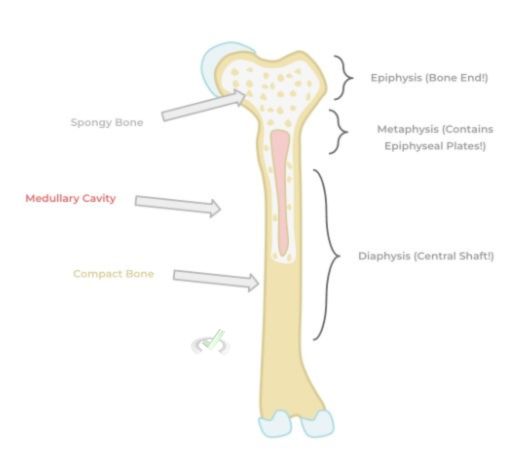
Additionally, note the different types of bone tissue present which includes compact and spongy bone — they both are composed of bone tissue (which we’ll discuss in a second) but they differ in regards to the arrangement of the bone tissue.
Compact bone refers to bone tissue consisting of a dense, layered arrangement in order to add strength and protection for the bone — this type of bone tissue is found on the outer layer of the bone!
Conversely, spongy bone has its bone tissue arranged in more of a trabeculated or porous (just like a sponge!) and usually looks like there are many cavities present! This arrangement not only aids in shock absorption but is also where the bone marrow (which extends from the medullary cavity) is housed throughout the spongy bone!
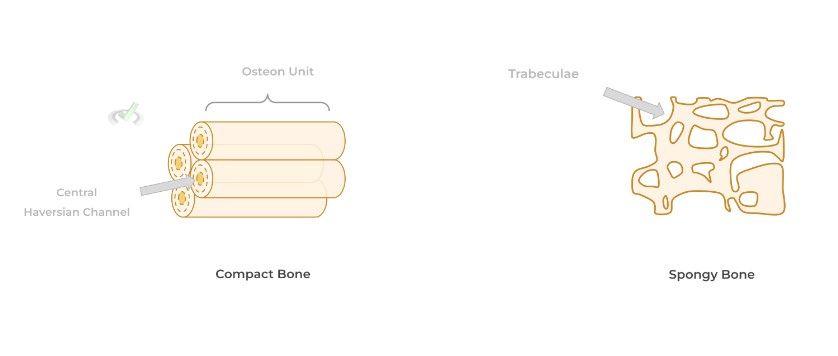
II. Bone Tissue Composition
As mentioned above, bone tissue is considered a connective tissue as it possesses all the requirements that connective tissue needs: it contains an extracellular matrix composed of a 1) ground substance and 2) protein fibers and also has a 3) cellular component!
In this case, the ground substance is composed of hydroxyapatite crystals which contain calcium and phosphate and has the molecular abbreviation as Ca₁₀(PO₄)₆(OH)₂. Embedded within the hydroxyapatite ground substance are collagen and elastic fibers which add tensile strength and flexibility!
Finally there are 3 main cell types associated with bone tissue: osteoblasts, osteoclasts, and osteocytes. Osteoblasts function to aid in the formation of bone tissue while osteoclasts work to break down bone tissue — these 2 functions of these cells are primarily regulated by osteocytes which are actually the most abundant cell type in bone tissue!
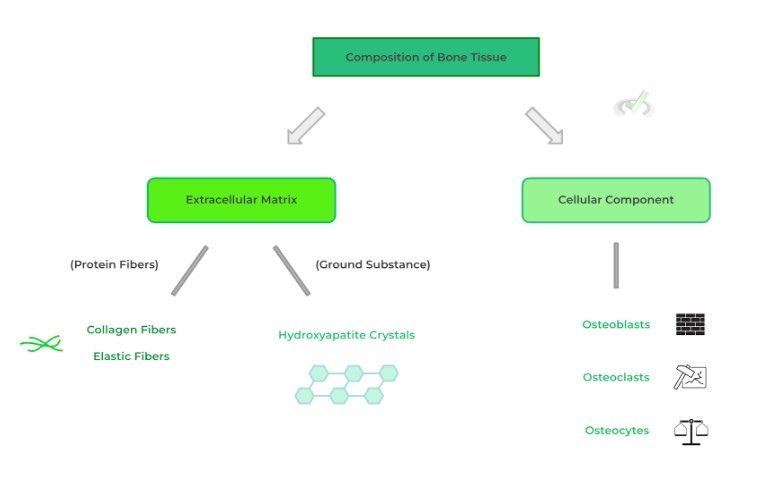
III. Osteon Structure
Finally, let’s get into the structure of compact bone in a little more detail as it has various subtle features which are important to understand. Simply put, an osteon is the fundamental structural unit of compact bone!
Try to think of an osteon as a cylinder composed of concentric layers of bone tissue referred to as lamellae. Located within between these layers of lamella are the osteocytes while the osteoblasts and osteocytes are located on the periphery.
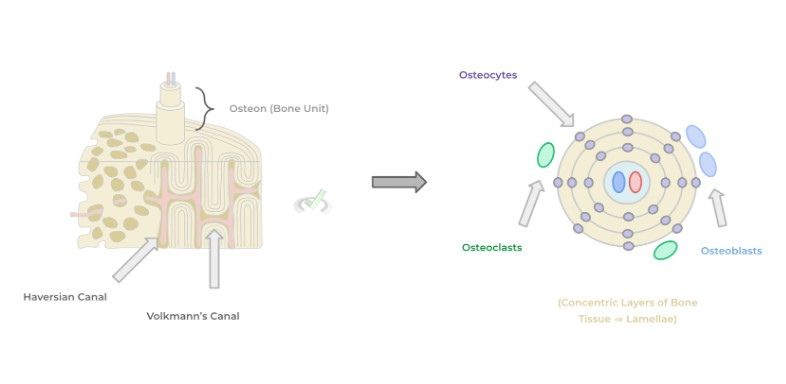
At the center of the osteon cylinder is a canal called a Haversian canal — this is where blood vessels, lymphatics, and nerves run through VERTICALLY in order to supply the osteon.
A similar channel, called a Volkmann’s canal, is also present and contains the same vessels as those of the Haversian canal; however, the vessels simply run PERPENDICULAR to those of the Haversian canal.
III. Bridge/Overlap
It might be helpful to review what constitutes the main components of connective tissue being that bone tissue is characterized into this tissue type! Let’s go ahead and review these concepts and also give some other examples to compare with bone tissue!
I. Components of Connective Tissue and Comparing Examples
Most connective tissue requires 3 main components: 1) a ground substance, 2) protein fibers, and 3) associated cells. The ground substance is defined as a gel-like, amorphous substance in which the protein fibers and other associated cells can be embedded in — together, the ground substance and the protein fibers form the extracellular matrix!
Go ahead and take a look below at some examples of connective tissue and see what are the specific names for the different types of ground substances and associated cells!
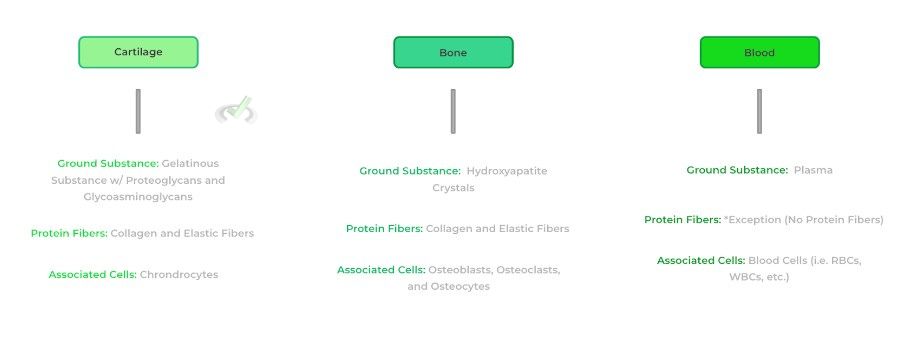
IV. Wrap Up/Key Terms
Let’s take this time to wrap up & concisely summarize what we covered above in the article!
A. Macroscale Covering
When discussing all the 206 bones in the human body, they can be studied on a grandeur scale in regards to how they all collectively come together to form the skeletal system!
I. Broad Categorization of the Skeletal System
The skeletal system can be divided into 2 main categories: the axial and appendicular skeleton. The axial skeleton forms the central axis of the skeleton and the body and consists of bones such as the skull, vertebrae, thoracic cage, etc.
The appendicular skeleton simply refers to all the other bones outside of the axial skeleton — they get their name because they attach/append to the axial skeleton!
II. Points of Attachment and Movement
There are various connective tissue types which aid in the connection of bones to each other as well as muscle. Ligaments are connective tissue which connect one bone to another while tendons are connective tissue which connect muscle to bone!
A joint refers to an interaction point between two bones which also facilitates movement around an axis. Joints are composed of various amounts of connective tissue such those mentioned above.
In addition, the bones of joints also contain hyaline cartilage on the interaction surface! Additionally, joints are lined by a synovial membrane which secretes synovial fluid — together, synovial fluid and hyaline cartilage aid in minimizing frictional stress.
B. Microscale Covering
Similarly, the anatomy of the skeletal system can be studied on a smaller scale, particularly covering the structure of long bones as well as the bone tissue on a microscopic level!
I. Basic Structure of Long Bone
The long bone has 3 main components: the diaphysis, epiphysis, and the metaphysis. The diaphysis refers to the central long shaft and the epiphysis refers to the end of the long bone.
The metaphysis essentially connects the diaphysis and epiphysis and is also where the epiphyseal plates are located!
The central portion of the diaphysis contains the medullary cavity which houses red and yellow bone marrow. Red bone marrow serves as the site for hematopoiesis while yellow marrow serves as an extra storage source of fat!
Additionally, there are 2 types of bone tissue: compact and spongy bone. Compact bone is found on the outer layer of bones and is arranged in more dense layers while the spongy bone has a more trabeculated, porous pattern!
II. Bone Tissue Composition
The bone tissue is a type of connective tissue as it contains all the requirements to be classified as this tissue type. It contains an extracellular matrix composed of protein fibers (collagen and elastic) as well as a ground substance composed of hydroxyapatite crystals!
There are several cells associated with bone tissue including osteoblasts, osteoclasts, and osteocytes. Osteoblasts work to increase bone tissue formation while osteoclasts work to degrade bone tissue — osteocytes have function in regulating these latter 2 bone cells.
III. Osteon Structure
Think of osteons as the main structural unit of compact bone. Picture osteons as cylindrical units consisting of concentric layers of bone tissue called lamellae — between the lamellae are osteocytes with osteoblasts and osteoclast located on the periphery.
The center of the osteon contains the Haversian canal which is where various vessels travel to supply the osteon. Traveling perpendicularly are the Volkmann’s canal which house the same vessels and connective osteons to one another!
V. Practice
Take a look at these practice questions to see and solidify your understanding!
Sample Practice Question 1
Rupture of the Achilles tendon is one of the most significant and devastating sports injuries for an athlete. Which of the following structures are connected to one another via the Achilles tendon?
A. Calcaneus Bone to Gastrocnemius Muscle
B. Calcaneus Bone to Fibula Bone
C. Achilles Tendon to Patellar Tendon
D. Gastrocnemius Muscle to Quadriceps Muscle
Ans. A
Even if you haven’t seen or are familiar with these structures, don’t worry! We can use the definition of a tendon to solve the problem! A tendon is a connective tissue which connects muscle to bone — as such the only plausible answer to this would be A. Answer B. describes the definition of a ligament which connects one bone to another!
Sample Practice Question 2
A fracture of the bone can possibly cause a hematoma which is where there's localized bleeding, in this case from the bone. A fracture damaging which bone structure could potentially cause a hematoma?
A. Yellow Bone Marrow
B. Hyaline Cartilage
C. Synovial Membrane
D. Haversian Canal
Ans. A
Recall that the Haversian canal refers to the central portion of an osteon which houses various blood vessels to supply the osteon. The fracture causes damage to the Haversian canal, the underlying blood vessels could also be damaged and cause a hematoma!







 To help you achieve your goal MCAT score, we take turns hosting these
To help you achieve your goal MCAT score, we take turns hosting these 





















 reviews on TrustPilot
reviews on TrustPilot